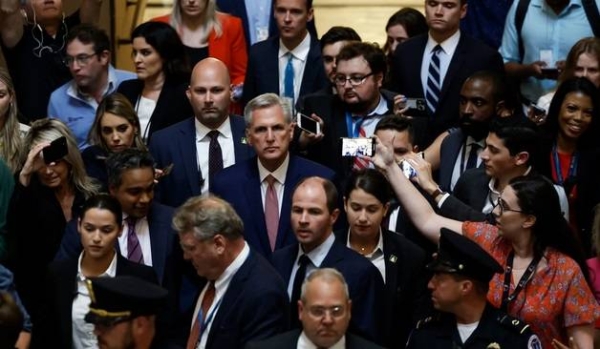
There is no weekend in global politics and last Saturday was no exception, with the alarming news coming out that Russia had made a deal with Belarus to station tactical nuclear weapons on its territory. The construction of a storage facility for tactical nuclear weapons in Belarus is expected by July 1, while the Kremlin promised that it would not transfer control of the arms to Minsk. Russia has already moved in a few Iskander tactical missile systems, in addition to stationing 10 aircraft in Belarus capable of carrying tactical nuclear weapons.
NATO called such rhetoric “dangerous and irresponsible,” while Ukraine has asked for an extraordinary meeting of the UN Security Council, calling the Kremlin’s actions “nuclear blackmail.”
But how likely is this to raise the stakes and lead to genuine nuclear conflict? To calculate this possibility, several different matters need to be considered. How big is Russia’s nuclear arsenal? What is the tactical thinking behind this step? Unlike the US, Russia has not deployed nuclear weapons outside its borders since 1991. What does this step mean in the context of the great power competition and its arms race?
From a certain perspective, the news is actually business as usual, since Russia and Belarus already have ongoing collaborations in the nuclear field. Minsk has its first nuclear power plant under construction. In November 2020, the first of its two units was linked to the electricity grid. The project was funded by Russia. Alexander Lukashenko, the leader of Belarus, also previously stressed that it was vital that tactical nuclear weapons were stationed in the country, since it has a border with Poland, which is a NATO member.
Undoubtedly, the war is pushing Russia and Belarus into a closer alliance, putting more pressure on Minsk to be further involved. There is also a clear rationale of attempting to counter Western policies. More specifically, it can be related to the UK’s statement that it would supply Ukraine with tank shells containing depleted uranium. This news was circulating during the visit of Chinese President Xi Jinping to Moscow and, after their meeting, Vladimir Putin said: “If all this happens, Russia will have to respond accordingly, given that the West collectively is already beginning to use weapons with a nuclear component.” The UK is among the world’s top five nuclear powers. But Russia possesses larger nuclear facilities and in theory could respond in a variety of ways.
In a February 2022 TV appearance, Putin stated that he was putting Russia’s nuclear arsenal on high alert. As the successor to the Soviet Union, the country has the largest global stockpile of nuclear warheads. According to the Bulletin of the Atomic Scientists, as of 2022, Russia had 4,477 military warheads, made up of 1,588 strategic intercontinental missiles deployed on ballistic missiles and at heavy bomber bases and 2,889 reserve/nondeployed warheads. Meanwhile, the US has a stockpile of 3,708 warheads, with 1,770 being deployed and 1,938 kept in reserve. That means that both Washington and Moscow could destroy the world many times over.
Both great powers’ nuclear policies are ambitious and alarming, even before we consider the actions and developments of other nuclear powers.
Dr. Diana Galeeva
Drawing an analogy with US nuclear policies, Putin has called the moves in Belarus “nothing unusual.” He has argued that the deal does not breach nonproliferation agreements, while suggesting that “the United States has been doing this for decades.”
Especially since 2014, Russia has developed and modernized its facilities, such as upgrading the nuclear weapons storage site in Kaliningrad, which is about 50 km from the Polish border. The US’ 2022 Nuclear Posture Review stated that Russia and China were both modernizing their nuclear forces and Washington would follow a strategy based on arms control to head off costly arms races. Meanwhile, Russia’s president has sought to highlight the US’ development of new types of nuclear weapon. Without any doubt, both great powers’ nuclear policies are ambitious and alarming, even before we consider the actions and developments of other nuclear powers.
The problem can be said to reflect a “realist” view of the world, as it is understood in international relations studies. In this perspective, power, which is especially concentrated in military power, is driven by realpolitik. Nuclear power is a means of showing strength, alongside other forms of military capacity, and, for the realist, this key attribute of power cannot be ignored in negotiations and relations between nations. This may include a return to nuclear blackmail policies by the great powers that have nuclear arsenals — a game of brinkmanship. The situation is all the more alarming since these policies affect not only the two main players in this arms race, but the whole world.
The only plausible solution to help slow the rhetoric and reverse any actions toward the possible utilization of these nuclear arsenals is proactive policies by other actors, such as by facilitating peace negotiations, even if Russia and the US are not formally in conflict. China, Saudi Arabia, Turkey and the UN could all play a brokerage role here. It is time to be proactive so that the world can avoid the catastrophic implications of the building standoff.
Ultimately, a nuclear arms race is a misnomer. Unlike a true contest, such as a horse race, where the winner is determined by their speed, skill and talent, a nuclear arms race cannot reward the winner — it only makes us all losers. The only way to win such an arms race is to be the negotiator or mediator who defuses the situation for the good of everyone.
Dr. Diana Galeeva is a former academic visitor to St. Antony’s College, Oxford University (2019-2022). Twitter: @Dr_GaleevaDiana












